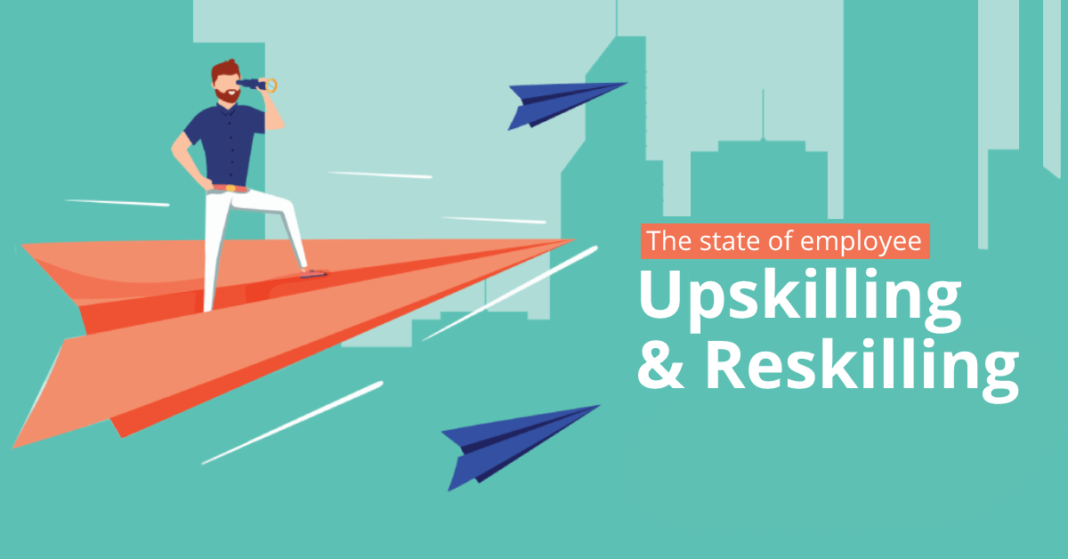Empowering Employees through Upskilling and Reskilling
In this changing world, helping employees learn new things (upskilling) or learn different jobs (reskilling) is super important. It’s like giving them tools to be even better at work. Imagine leveling up in a game—it’s like that, but for real life.
When employees know more, thanks to the power of upskilling and reskilling, they can do more and feel proud. It’s not just about excelling in their jobs today but also about being prepared for the challenges of tomorrow.
Just like our logo mat welcomes everyone at the door, a commitment to continuous learning invites employees to step into a world of growth.
Empowering employees through upskilling and reskilling is like building a strong team ready to face any challenge that comes their way.
So, let’s explore how this supercharge can improve work and life!
1. Assessment of Skills Gap
Figure out what skills your employees have and what skills they need for their jobs. It’s like comparing what they know with what’s required. This helps design training that targets their needs.
For example, if someone’s job needs computer skills but needs them, that’s a gap. By knowing these gaps, the company can plan training to fill them and make employees better at their jobs.
It’s like ensuring everyone has the right tools to do their work well.
2. Clear Communication

Talk and explain things in a way that everyone understands. It’s like sharing information with simple words and examples so nobody gets confused.
When bosses tell employees about changes or goals, it helps everyone know what’s happening. Good communication is like giving directions that are easy to follow. People can ask questions and get answers that make sense.
This way, everyone knows what’s expected and can work together better.
3. Tailored Learning Paths
Tailored learning paths are custom-made learning plans. They’re designed for each person based on what they need to learn and their goals.
Imagine getting a puzzle with just the pieces you need to complete. Instead of everyone learning the same things, they learn what helps them most. It’s like a menu where you pick the dishes you want.
This way, people can grow in the areas that matter for their jobs and future. It’s about getting the right skills to succeed, like having a map that guides you where you want to go.
4. Access to Learning Resources
Make sure they have tools and materials to learn new things. It’s like having a library full of books but for learning skills. These resources can be online courses, videos, books, and classes.
Just like having ingredients to cook, you get what you need to learn better. It’s important because it helps you understand things in different ways. If you want to learn about computers, you can find lessons that explain it well.
Access to these resources is like having a big toolbox for your brain, making it easier to learn and grow.
5. Mentorship and Coaching

Mentorship and coaching are like having a helpful friend or guide at work. They’re experienced people who show you the ropes and help you improve. Imagine learning to ride a bike with someone holding onto the back.
Mentors share their wisdom and advice, while coaches give tips for improving. They’re like a cheering squad that helps you do your best. They need help clarifying questions and support you if you’re stuck or unsure.
Having mentors and coaches is like having someone on your team who’s been there, done that, and wants to help you succeed.
6. Feedback and Evaluation
Feedback and evaluation are like getting a report card at school but for work. It’s when people tell you how you’re doing and what you can do better. It’s like a map that shows where you are on your journey.
If you drew a picture, they’d say what’s good and what could be improved. This helps you know if you’re on the right track and what to focus on. Just like a coach giving pointers in a game, feedback and evaluation help you play your job better. It’s like getting directions to reach your goals step by step.
7. Inclusivity
Make sure everyone feels welcome and part of the group. It’s like having a big family where everyone gets a seat at the table. Nobody is left out because of who they are.
It’s about treating everyone fairly, no matter where they come from or how they look. Imagine a game where everyone can play, no matter their skill level.
Inclusivity is like that—it ensures everyone can join in and contribute. It’s important because when everyone is included, we get different ideas and perspectives, making everything better.
8. Continuous Learning Culture
Continuous learning culture is having a habit of always wanting to learn new things. It’s not just at school but also work. Imagine if learning was a game you play every day.
People in this culture love discovering and growing, like how plants keep growing. They’re curious and like to try new ways of doing things. It’s like having a never-ending adventure of gaining knowledge.
Everyone shares what they know in a workplace like this, and nobody feels stuck. It’s a place where being better today than yesterday is exciting and normal.
9. Technology Integration
Use gadgets and technology to make things better and easier. It’s like having a robot helper in your daily tasks. Like using a smartphone for many tasks, technology helps you do things faster and smarter at work.
It’s like having a magic wand that helps with tough tasks—for example, using computers to teach or virtual reality to practice skills.
Technology integration is like adding cool tools to your toolbox. It makes work smoother, like riding a bike with training wheels until you can balance perfectly.
10. Managerial Support
Managerial support is like having a friendly guide at work. They’re bosses who help and encourage you. It’s like a coach on your team.
They listen to your ideas and problems. If you need tools or help, they’re there. They’re like a safety net if you make a mistake.
Imagine if your manager was like a big sibling who’s got your back. They care about your growth and make sure you’re okay.
When managers support you, it’s like having a strong wind at your back, making your work journey easier and more enjoyable.
Conclusion
Ultimately, helping employees learn and grow through upskilling and reskilling is like planting seeds that turn into strong trees. People with the right skills are confident and can handle new things.
It’s like a key that opens doors to success for them and the company. Just like a puzzle coming together, their improved skills fit well with the company’s goals.
So, by investing in their growth, we create a win-win situation—happier employees and a stronger, more adaptable workplace that’s ready for whatever the future brings.
